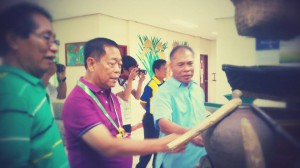In time with the National Museum and Galleries Month in October, Philippine Rice Research Institute (PhilRice) has established its second branch of Rice Science Museum in San Mateo, Isabela. 
With the opening exhibit theme titled, Bountiful Harvest, the branch museum highlights the role of Isabela, Philippines’ second highest rice-growing province, in providing enough food for the country. The museum also showcases the interaction among the rice varieties – hybrid, inbred, and traditional, in helping the farmers achieve better yield.
“Our exhibit shows that all varieties, whether traditional or modern, contribute in ensuring our food supply. Our rice collections from Cordillera are planted for household consumption and few for exports; while our displays from irrigated lowland are cultivated for the national market,” Johanna Portilla, museum curator said.
Based on statistics, Isabela produces 15% of the aggregate annual and has a rice self-sufficiency rate of 224%.
“We want the Isabelinos to be aware and be proud of this achievement and for the youth to appreciate our rice farmers and our rice heritage. Our sections on traditional and modern farm implements will also educate the public on agricultural development and how these implements have changed the ways of farming,” she said.
Portilla also said that the museum also contains a section showing the differences between hybrid and modern varieties so farmers may be well-informed in choosing what varieties to plant.
Meanwhile, the main Rice Science Museum in Nueva Ecija recently hosted the
Botong Francisco: A Nation Imagined exhibit in partnership with the Ayala Museum.
Ditas Samson, senior curator and head of publications and research
of the Ayala Museum, said that the 25 painting reproductions of the country’s second national artist show three themes that tie up the cycle of life in a rural town in the 1940s and 1950s.
“Planting rice is not only a popular folk tune but is also a beloved scene in Philippine painting….. Botong’s three themes of hometown, the land, and celebration show the joyful and symbiotic relationship of man and nature in ensuring progeny and produce, and a life of peace and abundance,” she said.
The senior curator said that by presenting informative and relevant exhibition on rice culture, traditions and technology to the general public and to students, the Rice Science Museum is playing its role in ensuring the food supply of the nation by encouraging young minds to think of agriculture as a career and have a role in feeding the nation.
The Rice Science Museum is a Department of Tourism (DOT) – accredited tourist facility and a Local Government Unit-licensed tourist establishment based in Science City of Muñoz, Nueva Ecija. It also has a branch in Batac, Ilocos Norte.




